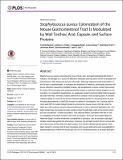| dc.contributor.author | Misawa, Yoshiki | en_US |
| dc.contributor.author | Kelley, Kathryn A. | en_US |
| dc.contributor.author | Wang, Xiaogang | en_US |
| dc.contributor.author | Wang, Linhui | en_US |
| dc.contributor.author | Park, Wan Beom | en_US |
| dc.contributor.author | Birtel, Johannes | en_US |
| dc.contributor.author | Saslowsky, David | en_US |
| dc.contributor.author | Lee, Jean C. | en_US |
| dc.date.accessioned | 2015-08-03T14:02:10Z | |
| dc.date.issued | 2015 | en_US |
| dc.identifier.citation | Misawa, Yoshiki, Kathryn A. Kelley, Xiaogang Wang, Linhui Wang, Wan Beom Park, Johannes Birtel, David Saslowsky, and Jean C. Lee. 2015. “Staphylococcus aureus Colonization of the Mouse Gastrointestinal Tract Is Modulated by Wall Teichoic Acid, Capsule, and Surface Proteins.” PLoS Pathogens 11 (7): e1005061. doi:10.1371/journal.ppat.1005061. http://dx.doi.org/10.1371/journal.ppat.1005061. | en |
| dc.identifier.issn | 1553-7366 | en |
| dc.identifier.uri | http://nrs.harvard.edu/urn-3:HUL.InstRepos:17820844 | |
| dc.description.abstract | Staphylococcus aureus colonizes the nose, throat, skin, and gastrointestinal (GI) tract of humans. GI carriage of S. aureus is difficult to eradicate and has been shown to facilitate the transmission of the bacterium among individuals. Although staphylococcal colonization of the GI tract is asymptomatic, it increases the likelihood of infection, particularly skin and soft tissue infections caused by USA300 isolates. We established a mouse model of persistent S. aureus GI colonization and characterized the impact of selected surface antigens on colonization. In competition experiments, an acapsular mutant colonized better than the parental strain Newman, whereas mutants defective in sortase A and clumping factor A showed impaired ability to colonize the GI tract. Mutants lacking protein A, clumping factor B, poly-N-acetyl glucosamine, or SdrCDE showed no defect in colonization. An S. aureus wall teichoic acid (WTA) mutant (ΔtagO) failed to colonize the mouse nose or GI tract, and the tagO and clfA mutants showed reduced adherence in vitro to intestinal epithelial cells. The tagO mutant was recovered in lower numbers than the wild type strain in the murine stomach and duodenum 1 h after inoculation. This reduced fitness correlated with the in vitro susceptibility of the tagO mutant to bile salts, proteases, and a gut-associated defensin. Newman ΔtagO showed enhanced susceptibility to autolysis, and an autolysin (atl) tagO double mutant abrogated this phenotype. However, the atl tagO mutant did not survive better in the mouse GI tract than the tagO mutant. Our results indicate that the failure of the tagO mutant to colonize the GI tract correlates with its poor adherence and susceptibility to bactericidal factors within the mouse gut, but not to enhanced activity of its major autolysin. | en |
| dc.language.iso | en_US | en |
| dc.publisher | Public Library of Science | en |
| dc.relation.isversionof | doi:10.1371/journal.ppat.1005061 | en |
| dc.relation.hasversion | http://www.ncbi.nlm.nih.gov/pmc/articles/PMC4511793/pdf/ | en |
| dash.license | LAA | en_US |
| dc.title | Staphylococcus aureus Colonization of the Mouse Gastrointestinal Tract Is Modulated by Wall Teichoic Acid, Capsule, and Surface Proteins | en |
| dc.type | Journal Article | en_US |
| dc.description.version | Version of Record | en |
| dc.relation.journal | PLoS Pathogens | en |
| dash.depositing.author | Wang, Xiaogang | en_US |
| dc.date.available | 2015-08-03T14:02:10Z | |
| dc.identifier.doi | 10.1371/journal.ppat.1005061 | * |
| dash.authorsordered | false | |
| dash.contributor.affiliated | Saslowsky, David E. | |
| dash.contributor.affiliated | Lee, Jean | |
| dash.contributor.affiliated | Wang, Xiaogang | |


